The Best and Worst of NAMM 2013
Over the weekend, the National Association of Music Merchants (more commonly referred to simply as […]
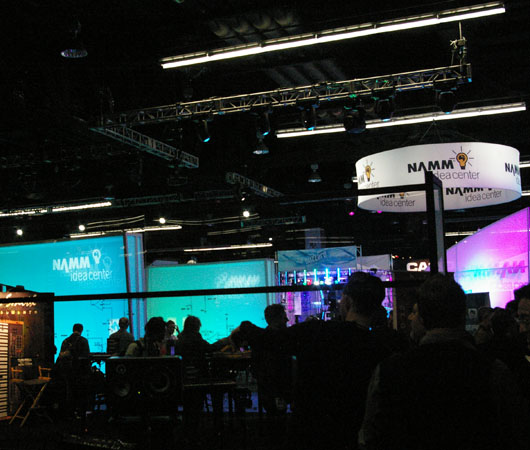
Over the weekend, the National Association of Music Merchants (more commonly referred to simply as NAMM) hosted its annual conference in Anaheim, California—a gluttonous four days where the sounds of distant equipment demos, corporate presentations, and the combined drooling of gear nerds makes for an overwhelming, but still very much exciting atmosphere. After spending a full day (which was pretty much our limit) entrenched in the trade show booths and walking amongst the masses of fellow wide-eyed attendees, XLR8R has tallied up the five essential highlights and embarrassments of this year’s NAMM conference.
THE BEST
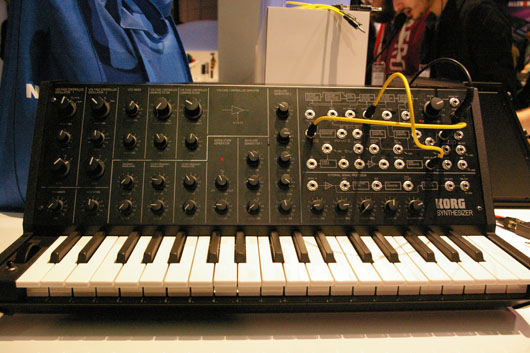
Korg’s MS-20 Mini
Just a few days before NAMM got underway last Thursday, rumors were spreading across the web that Korg planned to unveil a new version of its legendary MS-20 analog synth. As it turns out, the rumors were true, and the proof was prominently on display in the form of the compact (86% of the original size) MS-20 Mini, which added MIDI functionality and USB connectivity to the company’s classic, monophonic analog synth. Best yet, the design of the “Mini” version is said to have been overseen by the same engineer who designed the original unit back in the late ’70s, and Korg has somehow managed to bring this little bundle of joy into the world with a street price around $599.
Numark’s Orbit
Numark rolled out a load of new pieces during the conference, but the wireless, videogame controller-inspired Orbit MIDI controller certainly sparked our imagination. The handheld unit (it’s about the size of an iPad Mini) seemed to combine convenience and useful open-endedness into a clever package featuring 16 pads with 4 selectable banks and 16 virtual knobs per bank. At the booth, Numark promised a ridiculous amount of wireless range (between 200 and 300 feet) and said the unit would retail somewhere around $99. And for the gamer in all of us, there are even triggers on the left and right shoulders of the unit—similar to the “L1” and “R1” buttons on a PlayStation controller—a feature which, along with its ability to respond to tilt and motion via the “accelerometer,” makes the Orbit a really unique MIDI controller.
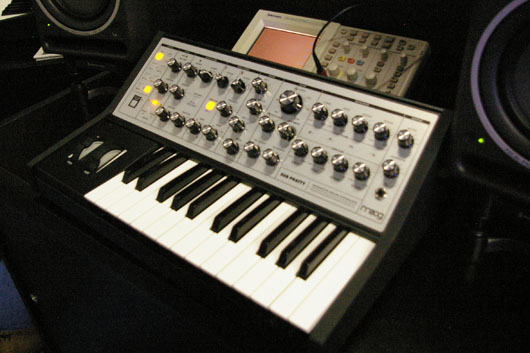
The Moog Sub Phatty and the Moog Booth
In a lot of ways, Moog just gets it. The company’s newest analog synth, the Sub Phatty, was something almost every NAMM attendee was excited to try out, and it really delivered, sounding as thick and luscious as any Moog, but also unique amongst the company’s legendary synth lineage—even being toted as the “grittiest” Moog synth to date due to its new Multidrive circuit. Furthermore, Moog’s booth was clearly the place to be, putting both a aluminum- and a gold-plated Voyager on display for us to gawk at and inviting legends like Bernie Worrell and even Stevie Fucking Wonder to come noodle on the monophonic keyboards.
Dave Smith Instruments Prophet 12
Only a few months after celebrating the 30th anniversary of MIDI, Dave Smith—its creator—is certainly nowhere near letting up, and the company which bears his name, Dave Smith Instruments, surprised many by announcing a brand-new synth, the Prophet 12, on the first day of NAMM. The shiny new unit is a behemoth of a keyboard, complete with 12-voice polyphony (each voice utilizing up to four oscillators) and a jaw-dropping list of bells and whistles that includes a tuned feedback path, a four-tap stereo delay, and a new “Character” section, which allows for users to adjust such elusive tone qualities as “Drive,” “Hack,” “Decimation,” “Girth,” and “Air.” With a projected street price around $2999, the Prophet 12 is certainly not for everyone, but it’s impossible to deny just how powerful a piece it is after pressing those keys and tweaking its many knobs.
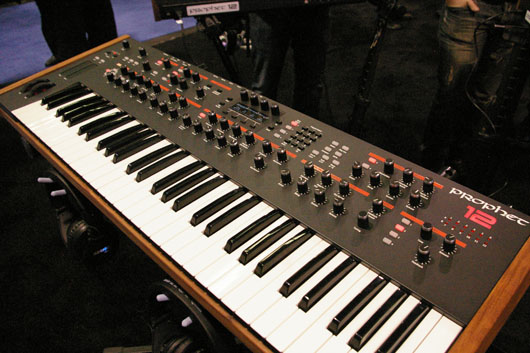
A welcome lack of EDM
Too often, the corporate formula for success seems to follow this path: find a trend, incorporate said trend into one’s marketing scheme, sell product. In the days leading to the conference, we feared that no “trend” was more ripe to be overblown at this year’s NAMM than the rise of the dreadful term—and music—of EDM. Whether it is a sign of the haphazardly named genre’s waning influence or just the fact that companies thankfully realized the negative repercussions of aligning with such a craze, the presence of EDM-themed equipment or content was barely felt at NAMM—there were no dubstep drops championed, no trampoline-hopping DJ sets, and no products promising to make its user the next EDM star. We were pleasantly surprised.
THE WORST
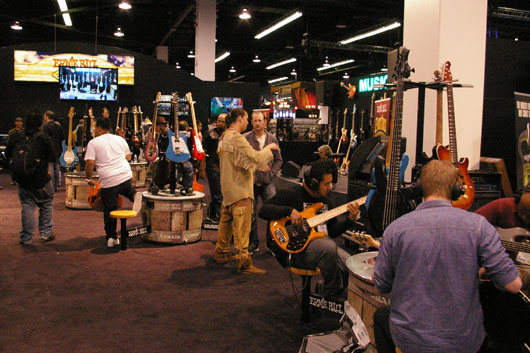
Wanking/Shredding
In many ways, the NAMM conference is just a Guitar Center blown up to massive proportions; around every corner lurks an overzealous salesman and—even worse—there seems to be a neverending supply of equally overzealous “musicians” ready to show off their skills loud enough for every passerby to hear just how hard they can tear shit up. In all honesty, NAMM is largely a trade show about musical instruments, so a certain amount of this is completely unavoidable, but of course, there are those who live life by “turning it up to 11,” and those guys suck. Of all the offenders, guitarists and bassists are by far the most infuriating. One can only imagine what’s going through their head as they take off ripping through an overdriven blues-rock solo or diving into the depths of their Jaco Pastorious-esque bass improvisation, but the fact of the matter is that no one cares and things are only turned up this loud as part of a sad attempt to garner some marginal amount of attention. Look dude, Stevie Wonder is jamming on some keyboards three booths down, so could you lay down the axe for a few minutes?
Guys playing with gear for way too long
Part of the fun of NAMM is that there are just so many fancy new toys to play with. Sprawled out on tables and stands everywhere are those top-of-the-line Pioneer CDJs and mixer you can’t afford, or some sweet new keyboard or even a vintage modular synth that is ready and waiting for you to plop on some headphones and start plugging away. Really, it’s easy to get carried away, but it seems appropriate to keep in mind that there are likely a shit ton of people there who also want to try their hand at the gear. Basically, NAMM is not the place for guys to write their one-man synth opus or finally put together that sweet DJ set, especially not when the unit’s pre-loaded tracks are the only source material. This is a time for users to explore for a bit, get a sense of what the piece does, and then move the fuck on or at least ask some questions.
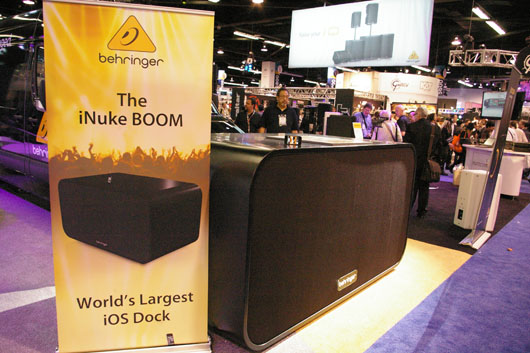
Behringer’s iNuke Boom
In all honesty, this monstrosity was probably just a bad joke—but at the edge of Behringer‘s large booth sat the iNuke Boom, toted as the “World’s Largest iOS Dock.” (Notice in the photo the iPhone on top of the unit, which should help give an idea of the actual size). Essentially a massive speaker in the middle of the showroom, the iNuke Boom steadily blasted tasteless music into the unprotected ears of innocent NAMM attendees. Whether it was a silly gag or something that the company actually imagined would be perceived as “cool” or “creative” is unclear, but either way it still stands as one of NAMM 2013’s most obvious misfires.
Unnecessary DJ Sets
As a DJ, being asked to spin at a NAMM booth is probably a conflicting proposition. On the one hand, it probably pays well and is without a doubt incredibly easy; but at the same time, it’s hard to imagine a more frivolous use of one’s talent. Aside from the occasional informative demo, it’s impossible to take a DJ set at NAMM seriously, especially when the jocks—who ostensibly are serving as nothing more than background music—throw down bangers and the type of fare they usually “rock the club” with. Sure, the vendors probably need some sort of sound to fill their booth, but watching anonymous DJs spin to a completely ambivalent audience within the context of a trade show is just depressing.
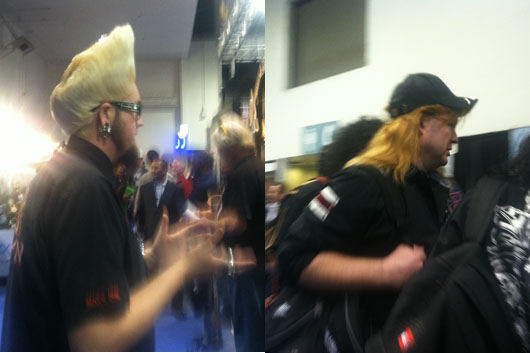
Bad Hair
NAMM brings a lot of different musical worlds together—there are the DJs, the synth nerds, the computer/technology geeks, the studio guys, the jazz players, the classical musicians, and—of course—a dizzying grab bag of rocker personalities. Somehow, every decade of rock-and-roll fashion still has a decent amount of people who identify with it, and even more incredibly, representatives from all of those cultures and eras manage to get their hands on NAMM badges. This results in things like leather pants, “groovy” sunglasses, and other stereotypical accessories becoming commonplace sightings, but the most questionable stylistic choices of all are always at the top of attendees’ heads. From dreads died in patterns and egregiously feathered manes to dangerously tall spikes and essentially every conceivable style of mullet ever dreamt up by man, the hodgepodge of terrible hairstyles was a constant reminder of the questionable types which make NAMM, well, NAMM.

